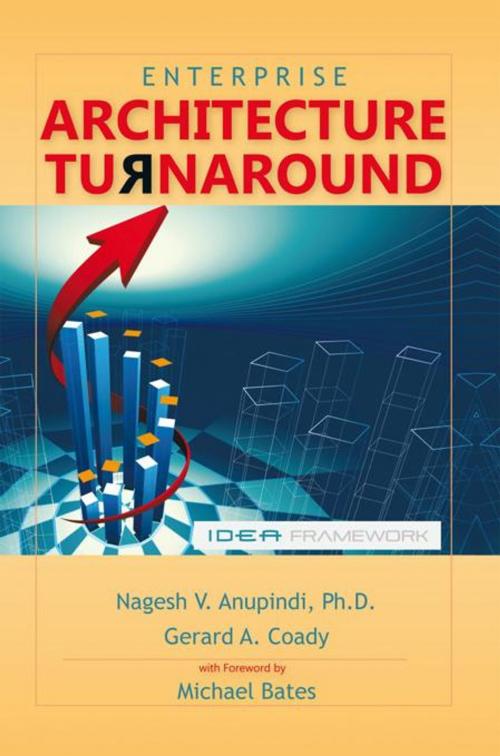Enterprise Architecture Turnaround
Nonfiction, Art & Architecture, Architecture, Reference, Reference & Language| Author: | Nagesh V. Anupindi, Gerard A. Coady | ISBN: | 9781466906969 |
| Publisher: | Trafford Publishing | Publication: | December 22, 2011 |
| Imprint: | Trafford Publishing | Language: | English |
| Author: | Nagesh V. Anupindi, Gerard A. Coady |
| ISBN: | 9781466906969 |
| Publisher: | Trafford Publishing |
| Publication: | December 22, 2011 |
| Imprint: | Trafford Publishing |
| Language: | English |
To provide structure and transparency to the complex world of IT, Enterprise Architecture was created. However, we created complexities within Enterprise Architecture with Frameworks that are not easily understandable and purposefully implementable. In this book, Nagesh and Gerry help to turnaround Enterprise Architecture organizations. They introduce a simple IDEA Framework that is based on common practices and investments within IT organizations. The Ten deliverables presented in this book bring structure and clarity to IT organizations that are 10-people IT shops and 1000+ IT staff enterprises alike.
This book is not an ivory tower work, it is actionable, applied Enterprise Architecture. It is also a healthy dose of EA tough love. If you want to know why EA fails, read the second chapter. It is introspective, it does not blame external forces: the not-my-fault syndrome. It also does not blame, in fact it hardly mentions, technology. To be fair, the Nagesh and Gerry do recognize external influences; however they are viewed as risks that must be managed.
Most corporations focus on this years budget, investments, and rewards. The same focus rolls downhill to the Information Technology department. If the IT department has not successfully communicated the budget and managed to spend it within the limits (10% variance), everything else may seem irrelevant. Eventually, Nagesh and Gerry started looking through current IT systems and IT assets to understand: (a) where the current funds were being invested, (b) how these investments jelled or were mandated because of the previous investments that had been made by IT, and (c) how the companys business priorities aligned with future technology needs, including the need to meet compliance requirements. Considering and discovering the answers to these three questions led Nagesh and Gerry to develop a definition of Enterprise Architecture that was based on technology investments Investment Driven Enterprise Architecture (IDEA) Framework.
The purpose of the IDEA Framework is to provide guidance on how the corporations future technology will be drafted and communicated. Its method is to utilize actual systems, hardware, people, and business functions in order to establish boundaries within which the IDEA Framework will work. The structure of the IDEA Framework differs from that of many others because it consists of key deliverables that fit into day-to-day activities and it accommodates an enterprise-wide strategic plan. It also provides for the much-needed interaction between these key deliverables and facilitates contributions from key stakeholders across Business Units and the various IT departments. In essence, the IDEA Framework takes the key deliverables, stakeholders, and organizations and demonstrates how they dynamically function together.
To provide structure and transparency to the complex world of IT, Enterprise Architecture was created. However, we created complexities within Enterprise Architecture with Frameworks that are not easily understandable and purposefully implementable. In this book, Nagesh and Gerry help to turnaround Enterprise Architecture organizations. They introduce a simple IDEA Framework that is based on common practices and investments within IT organizations. The Ten deliverables presented in this book bring structure and clarity to IT organizations that are 10-people IT shops and 1000+ IT staff enterprises alike.
This book is not an ivory tower work, it is actionable, applied Enterprise Architecture. It is also a healthy dose of EA tough love. If you want to know why EA fails, read the second chapter. It is introspective, it does not blame external forces: the not-my-fault syndrome. It also does not blame, in fact it hardly mentions, technology. To be fair, the Nagesh and Gerry do recognize external influences; however they are viewed as risks that must be managed.
Most corporations focus on this years budget, investments, and rewards. The same focus rolls downhill to the Information Technology department. If the IT department has not successfully communicated the budget and managed to spend it within the limits (10% variance), everything else may seem irrelevant. Eventually, Nagesh and Gerry started looking through current IT systems and IT assets to understand: (a) where the current funds were being invested, (b) how these investments jelled or were mandated because of the previous investments that had been made by IT, and (c) how the companys business priorities aligned with future technology needs, including the need to meet compliance requirements. Considering and discovering the answers to these three questions led Nagesh and Gerry to develop a definition of Enterprise Architecture that was based on technology investments Investment Driven Enterprise Architecture (IDEA) Framework.
The purpose of the IDEA Framework is to provide guidance on how the corporations future technology will be drafted and communicated. Its method is to utilize actual systems, hardware, people, and business functions in order to establish boundaries within which the IDEA Framework will work. The structure of the IDEA Framework differs from that of many others because it consists of key deliverables that fit into day-to-day activities and it accommodates an enterprise-wide strategic plan. It also provides for the much-needed interaction between these key deliverables and facilitates contributions from key stakeholders across Business Units and the various IT departments. In essence, the IDEA Framework takes the key deliverables, stakeholders, and organizations and demonstrates how they dynamically function together.















